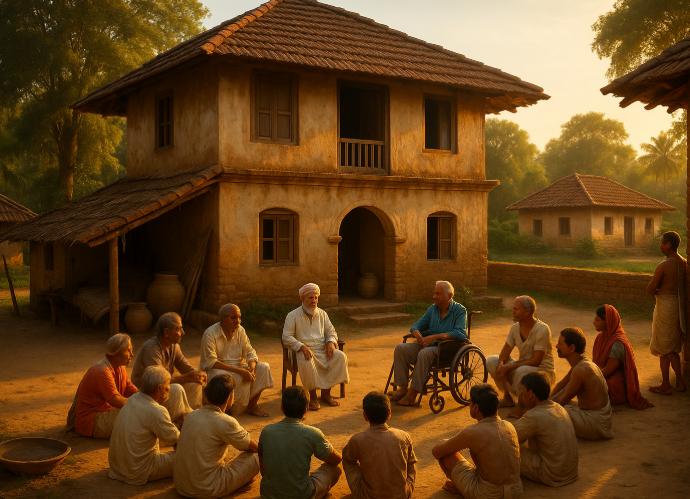West Bengal politics sits at the meeting point of caste identity, community blocks, and big ideas. The story moves through three phases:
-
the bhadralok-led era,
-
the rise and decline of Communism,
-
a new phase marked by Hindu nationalism and intense party competition.
Every party builds coalitions across caste, religion, language, and region. No single group decides power on its own.
1. The Bhadralok: Who They Are and Why They Matter
“Bhadralok” means the educated, urban, middle-class elite that shaped culture and administration for over a century. It is more a social umbrella than a single caste. Historically, three upper-caste groups fill much of this space:
-
Brahmins
-
Baidyas (Vaidyas)
-
Kayasthas
Features:
-
High value on education, literature, and public life.
-
Strong presence in Kolkata and district towns.
-
Deep links with universities, media, law, and bureaucracy.
-
Long influence over political parties, from Congress and the Left to today’s formations.
Over time, the bhadralok identity widened. Business communities, professionals, and upwardly mobile OBC/SC families also entered elite spaces through education and jobs. Yet, the original three-caste core still shapes leadership pipelines, opinion-making, and cultural norms.
2. Major Hindu Caste Blocks and Political Patterns
Mahishyas
-
A large peasant-producer OBC community in south Bengal (Howrah–Hooghly–Midnapore belt).
-
Politically active at the panchayat and municipal level.
-
Swing voters; leadership, local networks, and economic issues matter.
Rajbanshis (Koch)
-
Concentrated in North Bengal (Cooch Behar, Jalpaiguri, Alipurduar).
-
Identity and development are key issues.
-
Compete narratives: regional pride, welfare access, and jobs.
Namasudras (including Matua community)
-
A major SC group with roots in East Bengal (present-day Bangladesh).
-
Religious-social mobilization around the Matua faith centers.
-
Citizenship, migration, and recognition issues shape voting.
-
Highly courted by all parties.
Other SC Groups (Bagdi, Bauri, Malo, Dom, etc.)
-
Spread across rural and peri-urban belts.
-
Decisions shaped by welfare reach, housing, jobs, and local leaders.
-
Sub-caste links and panchayat networks affect turnout and choice.
Adivasi/Tribal Communities (Santhal, Oraon, Munda, Lodha, etc.)
-
Strong presence in Junglemahal (Jhargram, Purulia, Bankura, West Midnapore) and pockets of North Bengal.
-
Land rights, forest access, security, and local development are key.
-
Cultural pride and youth aspirations drive politics.
Marwari/Gujarati/Bihari/Hindi-speaking Communities
-
Concentrated in trade hubs and urban clusters (Kolkata, Asansol–Durgapur–Siliguri).
-
Business climate, law-and-order, and infrastructure shape choices.
-
Often decisive in close urban contests.
Brahmins / Baidyas / Kayasthas (upper-caste bhadralok core)
-
Influential in leadership, media, academia, and professions.
-
Voting varies by ideology, city/district context, and attitudes on culture, nationalism, and welfare.
3. Muslims in West Bengal
-
A large minority, concentrated in districts such as Murshidabad, Malda, Uttar Dinajpur, and parts of South Bengal.
-
Priorities: peace, jobs, education, welfare, and protection from communal tension.
-
Typically consolidate behind the party seen as most capable of ensuring safety and services.
-
Internal diversity by class, occupation, and locality creates local variations.
4. Christians in West Bengal
Christians form a small but influential community, roughly 0.6–0.8% of West Bengal’s population. Their strength lies in education, health, and social work, not just electoral numbers. They are a moral and civic minority, active across Kolkata, the hills, and tribal belts.
Distribution and Presence
-
Kolkata and Howrah: Anglo-Indian, Goan, and Dalit Christian families with long histories in education and public service.
-
Darjeeling, Kalimpong, Jalpaiguri, Alipurduar: Nepali-origin and tribal Christians, often connected to mission schools and church-based organizations.
-
Junglemahal and rural belts: Tribal converts forming part of mixed-village communities.
-
Nadia and Midnapore: Smaller groups from older missionary roots.
Influence
-
Christian-run schools, colleges, and hospitals (St. Xavier’s, Loreto, Don Bosco, Scottish Church, St. Paul’s) have shaped Bengal’s urban intellectual class.
-
Their reputation in education and health gives them moral influence beyond numbers.
Political Pattern
-
Traditionally lean towards secular and inclusive parties (first the Left, now Trinamool Congress).
-
Value peace, minority safety, and educational freedom.
-
Congress retains pockets of goodwill, while BJP has limited traction except in tribal belts.
-
In elections, their votes follow local candidates and issue-based appeals, not strict community blocs.
Christian Tribes of North Bengal and Junglemahal
In North Bengal and Junglemahal, a distinct Christian tribal segment plays a quiet but steady political role.
North Bengal
-
Communities: Oraon, Munda, Santhal, Kisan, and smaller Adivasi-Christian groups.
-
Districts: Jalpaiguri, Alipurduar, Cooch Behar foothills, and parts of Darjeeling.
-
Issues: Tea garden conditions, forest access, land rights, and education.
-
Politics: Mixed — older families recall Left-era protections; younger voters weigh central schemes and BJP’s national image. TMC gains when welfare delivery is strong.
Junglemahal (Purulia, Jhargram, Bankura, West Midnapore)
-
Many Santhal and Munda households have Christian members.
-
Churches and NGOs work on literacy, health, and women’s welfare.
-
Local factors dominate: safety, roads, job access, and respect for tribal identity.
-
TMC has strong presence via welfare and local schemes. BJP made gains in 2019–2021 through tribal outreach.
-
Their faith identity often merges with tribal culture; voting behavior follows village consensus rather than pure religious alignment.
Influence Channels
-
Church networks, youth fellowships, and community schools act as social anchors.
-
Pastors and lay leaders are respected mediators between parties and people.
-
They often urge peaceful participation, making them stabilizing agents in sensitive areas.
5. How Hindu Nationalism Emerged
-
Organizational work: Volunteer networks grew in small towns, border areas, and tribal belts.
-
Identity and security: Themes of national pride and border protection gained traction.
-
Refugee narratives: Citizenship and migration debates engaged Namasudra-Matua groups.
-
Urban middle class: Nationalism mixed with governance talk appealed to new voters.
6. Evolution and Downfall of Communism
Rise:
-
Land reforms and panchayats gave the Left grassroots legitimacy.
-
Trade unions and youth fronts created durable networks.
Decline:
-
Industrial stagnation, land conflicts, and generational fatigue eroded trust.
-
TMC filled the gap with welfare, emotion, and accessibility.
7. The Resurgence of Hindu Nationalism and BJP’s Rise
-
-
Growth in North Bengal (Rajbanshi identity, border issues).
-
Junglemahal gains via tribal mobilization.
-
Matua outreach through citizenship.
-
Urban peripheries resonated with nationalism and central schemes.
- BJP’s aggressive Hindutva politics claims to counter the minority appeasement politics of the ruling Trinamul Congress Government.
-
7. Party-Wise Support
TMC – Welfare, women, minorities, SC/ST, urban poor.
BJP – Rajbanshi, Matuas, sections of tribal belts, urban middle class.
Left Front – Legacy base among workers, teachers, and intellectuals.
Congress – Residual strength in Murshidabad–Malda axis.
8. Region-Wise Overview
| Region | Political Dynamics |
|---|---|
| Kolkata Metro | Educated middle class, civic issues, welfare perception. |
| Howrah–Hooghly–South 24 Parganas | Mixed caste belts, welfare networks, minorities. |
| Medinipur–Bankura–Purulia (Junglemahal) | Tribal welfare, roads, safety, jobs. |
| Burdwan–Asansol–Durgapur | Industrial votes, law and order, employment. |
| Murshidabad–Malda–Uttar Dinajpur | Muslim majority, peace and services key. |
| North Bengal (Cooch Behar–Jalpaiguri–Darjeeling) | Rajbanshi and tribal identity, tea garden distress. |
| Nadia–North 24 Parganas | Citizenship, refugee issues, border economy. |
25 Key Facts & Trivia
-
Bhadralok elite still shapes opinion and leadership.
-
Mahishyas dominate south Bengal’s OBC landscape.
-
Rajbanshis define North Bengal identity politics.
-
Matuas are key in border belts; citizenship is central.
-
Tribals in Junglemahal decide close seats.
-
Muslims consolidate for peace and welfare.
-
Christians, though small, are influential in education and tribal welfare zones.
-
Christian tribal votes matter in hills and Junglemahal panchayats.
-
TMC’s welfare net reaches women and poor families effectively.
-
BJP’s rise came from identity zones and border politics.
-
Left retains cadres but struggles with youth.
-
Urban swing areas watch central schemes and civic issues.
-
Clubs and cultural committees act as party intermediaries.
-
Tea gardens define class-based politics in North Bengal.
-
Education and service institutions run by Christians shape civil values.
-
Anglo-Indian and Goan Christians in Kolkata lean secular.
-
Church networks foster peace in tribal regions.
-
Citizenship debates polarize SC/OBC belts.
-
Panchayats control last-mile delivery.
-
Bhadralok opinions influence media framing.
-
Youth aspirations drive change more than ideology.
-
Minority safety narratives still shape Muslim-Christian votes.
-
BJP made symbolic Hindu unity gains in border areas.
-
TMC retains local trust via welfare delivery.
-
West Bengal’s politics is a mosaic—ideology, caste, faith, and welfare overlap everywhere.

Kalyan Chandra
Kalyan chandra is a political strategist, media and communication consultant with the expertise in public relations, marketing, political research, election campaign management, psephology and digital analytics. He focuses on strategic political consulting, offering services that include competitive research, public opinion collection, and digital media management. Kalyan has significantly contributed to successful campaigns across India with his meticulous approach and deep understanding of the political landscape.

